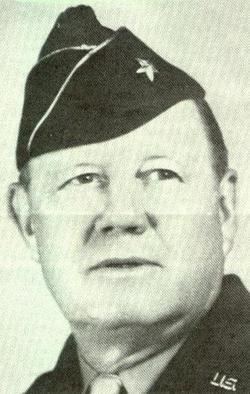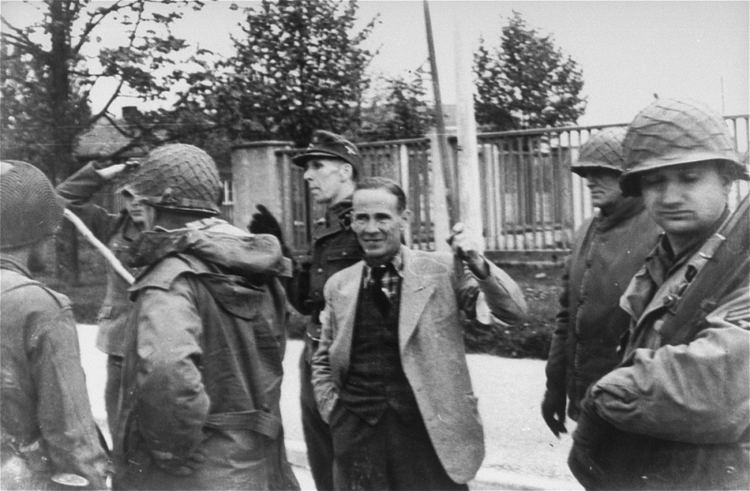Years of service 1917–1952 Rank Brigadier general | Name Henning Linden | |
 | ||
Born September 3, 1892Mound, Minnesota ( 1892-09-03 ) Allegiance United States of America Commands held 3rd Battalion, 22nd Infantry Regiment53rd Infantry RegimentTask Force LindenUnited States Army Military Arts Department, Army Engineer School Battles/wars World War IWorld War II Awards Silver StarLegion of MeritBronze StarArmy Commendation Medal Died March 15, 1984, McLean, Dranesville, Virginia, United States Place of burial Arlington National Cemetery, Arlington, Virginia, United States | ||
Henning Linden (September 3, 1892 – March 15, 1984) was a United States Army Brigadier General during World War II. He was prominent for his role in the liberation of the Dachau concentration camp while serving as Deputy Commander of the 42nd Infantry Division.
Contents
- Early life
- World War I to World War II
- World War II
- Dachau Liberation
- Post World War II
- Awards and Decorations
- Death and Burial
- Dachau Controversy
- Looting Controversy
- References

Early life
Henning Linden was born as Carl Henning Linden in Mound, Minnesota on September 3, 1892, to Swedish immigrant parents. He completed the Reserve Officer Training Corps program at the University of Minnesota and was a Cadet Captain, graduating in 1917 with a degree in civil engineering. He then joined the United States Army as a Second Lieutenant of Infantry, assigned to the 40th Infantry Regiment.
World War I to World War II
He commanded a company of the 33rd Infantry Regiment in Panama during World War I, and afterwards served in several command and staff assignments of increasing rank and responsibility. In the early 1920s Linden was Assistant Professor of Military Science for the Reserve Officer Training Corps program at the University of Maryland. In the early 1930s Linden was adjutant of the garrison at Fort Leavenworth, Kansas.
In 1936 he graduated from the Command and General Staff College and was reassigned to Fort McClellan, Alabama, where he commanded 3rd Battalion, 22nd Infantry Regiment.
In the early 1940s Linden was an Assistant Professor of Military Science for the ROTC program at Boston University.
World War II
At the start of World War II he was commander of the 53rd Infantry Regiment in the Aleutian Islands as the United States retook them from Japan.
In 1943 he was promoted to Brigadier General as Assistant Division Commander of the 42nd (Rainbow) Infantry Division. He commanded its three infantry regiments as "Task Force Linden" which arrived in Marseille, France, that fall, deployed in an attempt to prevent two German armies in Alsace from breaking out, and successfully defended along a 30-mile front. Two units of "Task Force Linden", the 222nd Infantry Regiment and 1st Battalion 242nd Regiment, were awarded Presidential Unit Citations for extraordinary heroism.
At the end of January, 1945 the rest of the division arrived in France, and as part of the Seventh Army the 42nd penetrated German defenses in the Haardt mountains, crossed the Siegfried Line, bridged the Rhine River, and captured the cities of Würzburg, Schweinfurt, Fürth and Donauwörth.
Dachau Liberation
On April 29, 1945 General Linden led a 42nd Division detachment to liberate the Dachau concentration camp. Journalists including Marguerite Higgins traveled with Linden's detachment, resulting in international headlines about the soldiers' liberation of more than 30,000 Jews and political prisoners.
Post-World War II
After World War II he served in occupied Austria as Deputy Commander of the American Occupation Zone. After returning to the U.S. he was Chief of the Army's Military Arts Department at the Engineer School until he retired in 1952.
Awards and Decorations
His awards included: the Silver Star; two Bronze Star Medals; two Legions of Merit; two Army Commendation Medals; World War I Victory Medal; World War II Victory Medal; European-African-Middle Eastern Campaign Medal with 3 bronze stars; Asiatic-Pacific Campaign Medal; American Defense Service Medal; and Army of Occupation Medal. He was also awarded the Croix de Guerre (France) and the Order of Leopold II (Belgium).
Death and Burial
General Linden died in McLean, Virginia on March 15, 1984. He was buried at Arlington National Cemetery, Section 1, Site 792-E.
Dachau Controversy
For years there has been an ongoing controversy between adherents of Felix L. Sparks and those of Linden over whether the 45th Infantry Division or 42nd Division Troops led by Linden were the actual liberators of Dachau. General Linden's son, Colonel (Retired) John H. Linden addressed the question in 1997's Surrender of the Dachau Concentration Camp, 29 APR 45: The True Account, referring to numerous first hand accounts and primary source documents to bolster his father's version of events.
Looting Controversy
Recent writers have found fault with Linden, Harry J. Collins and other officers who performed occupation duty after World War II, suggesting that they requisitioned luxury items from the Hungarian Gold Train for furnishing their offices and quarters —- items allegedly taken from Jewish families by the Nazis during the war. Linden is reported to have received 10 rugs for his quarters on the von Trapp Estate. Many items were not returned to their original owners, who had been killed or displaced during the war, but were later sold at auctions, with the proceeds used to aid war refugees.
